
Wine Culture and Information since 2002 - Volume 22
 Wine Culture and Information since 2002 - Volume 22 |
|
Issue 180, January 2019 |
Contents |
|
|
Italy: Wine is King Again |
|
The relationship Italy and the Italians have with wine is notoriously solid and deep: a love lasting for over two thousand years now and in the many expressions of private, social, formal and ritual life. Wine consumption in Italy evidently depends on factors, so to speak, of customs and fads, something concerning not only the preference of specific styles of wine but also of different beverages. Wine undeniably is the national drink of Italy, however this role in recent years has been undermined by other drinks, in particular beer. This is due to the interest the beverage of Ceres has received in recent years, in particular the so-called craft production which, undeniably, has contributed to a greater awareness and definition of beer quality. The phenomenon of the production of the so-called craft beer, it must be said, is particularly active in Italy and has evidently been able to shift part of the attention for wine towards this drink. Beer has not obviously been the only cause leading to a decrease in wine consumption in Italy. It will be remembered, in fact, the law concerning the lowering of blood alcohol content for driving vehicles, a measure that has evidently favored the consumption of drinks with a lower alcohol volume, such as beer. Wine has been, so to speak, a victim of this law because – in fact – the intake of just one glass of wine could, in some cases, exceed the minimum limit of the admitted blood alcohol content. Of course, the measure that in theory should discourage driving when someone is in a state of drunkenness is acceptable, but it is undeniable this has led to a contraction in wine consumption in Italy. The same happened to spirits and liquors although it should be noticed the difference regarding the attitude and the mode of consumption between wine and spirits. In this regard, it is undeniable beer had a better luck because, in general terms, it is characterized by an average alcohol volume of 5%, much lower – less than half – when compared to the average alcohol content of wine. This change in consumer preferences – in a sense, legally imposed – is still evident today by observing, in general terms, what can be seen in restaurant tables. Until recent times, the presence of a bottle of wine, as well as the simple carafe of the “wine of the house” was very common in most restaurant tables. Today, although bottles and carafes of wine can still be seen, the presence of sparkling and foaming glasses of draft beer, with some timid presence of bottled beers, is clearly more common than in the past. The legitimate concern to exceed the limit allowed by the law on blood alcohol content has undoubtedly influenced the choices of clients in restaurants and wine bars, it has evidently contributed to the decrease in consumption of wine. According to the news spread by Coldiretti (an Italian Association of Farmers), in recent years in Italy there has been a change of consumption trends, which has seen wine to be again in the preferences of Italians. In fact, Coldiretti informs that in the last five years there has been an increase in wine consumption of 8%. This figure, among the other things, ranks Italy in the third place in the world among the countries where there is the highest consumption, standing at 22.6 hectoliters in 2017. Only in the United States of America and in France there is a consumption greater than Italy: respectively 32.7 million hectoliters and a growth of 5.7%; 27 million with a 2.8% drop in the last five years. In regard to the increase in consumption expressed in percentages, in the last five years only China has been able to do better than Italy, recording an increase of 8.2%, while attesting its internal consumption to 17.9 million hectoliters: a significant value considering most of the wine consumed in China is imported. It must also be said not all the wine produced in Italy – of course – is destined for internal consumption: the share of sales abroad represents a fundamental and essential part of the budget for each winery. In this regard, Coldiretti informs «Wine is the first product of agri-food exports and it is no coincidence the turnover achieved abroad now exceeds the one at national level». By considering the values produced by the Italian wine production, Coldiretti notes that in Italy 310,000 farms are dedicated to grape harvesting and almost 46,000 of them are also involved in wine making, with an area destined to vine growing equal to 652,000 hectares. Italian wine production – according to Coldiretti – generates a value of 10.6 billion euros, of which the majority derive from sales abroad. Moreover, wine in Italy ensures the employment of 1.3 million people from the vineyard to the winery, as well as to commercial distribution, activities and services related to wine. In the last five years, apparently and in general terms, the relationship Italians have with wine has also changed, as it seems they tend to favor quality and conscious consumption. It must be noted that, although wine cannot be excluded from these considerations, those who decide to abuse alcohol consumption generally choose other alcoholic beverages. This is also clearly because of the cultural change affecting wine in the last twenty years, a period in which – there is no doubt – the communication and press have been particularly focused on the beverage of Bacchus, also emphasizing the value of the territory and the uniqueness of what is produced by the vineyard. Undeniably, wine has got an élite role, losing its previous identity as a beverage–food, a fundamental element of the culture and tradition of the tables of the peoples of the Mediterranean. It is undeniably good to know wine is regaining its historic dominance among Italians' preferences. Moreover, in case this is also associated to conscious and critical consumption favoring quality, we are certainly happy for this. Long live the wine! Antonello Biancalana
|
||||
Contrasts of Fortana and Grenache NoirThe most famous of the representatives of the so-called wines of the sands – Fortana – compared to a variety of character today cultivated in most of the wine making countries of the world |
|
In the world of wine, it frequently happens, the combination of particular environmental conditions, the composition of soil and, last but not least, specific grape varieties, can give life to wines with unique personalities. The indispensable contribution of man allows these factors to be transformed into wine, for his own advantage of course, no less important, for his own pleasure as well, in order to create wines with decidedly unique characteristics. This is what occurs with one of the two varieties of the tasting by contrast of this month – Fortana – which in its main territory, Bosco Eliceo DOC, in the province of Ferrara, Italy, is an irreplaceable element for the creation of what are defined as wines of the sands. This definition, of course, is mainly due to the composition of the soil of this interesting wine area, capable of creating wines with a good personality. These considerations, of course, are true for any territory, environment and grape, however the conditions occurring in the territory of Bosco Eliceo are definitely unique. No less unique and of character is the second variety of our tasting by contrast – Grenache Noir – grape now considered international and cultivated in many countries of the world, even with different and local names. Fortana and Grenache Noir, regardless of the place and condition in which they are grown in, turn out to be extremely different, producing wines distant in many sensorial aspects. Immediate and lively wines for Fortana, of greater complexity and structure those produced with Grenache Noir. The production method obviously contributes to the definition of these differences, by also considering, moreover, Fortana is often vinified as a sparkling style, however there also are excellent examples of still wines.
|
|
Fortana associates its name and wines to the land of Emilia Romagna, in particular those in the province of Ferrara and Ravenna, a territory particularly known for the so-called wines of the sands produced, of course, with this grape. This red berried variety is also present, although in lesser quantity, in the territory of Parma and Reggio Emilia, particularly in the areas near the Po river. The name Fortana has a relatively recent history, as it is what has been chosen at the time of the registration of this variety in the Italian catalog of wine vines. In past times, in fact, Fortana was known as uva d'oro (Italian for “golden grape”), name with which there are written mentions since the 1500s. The origin of this name is however controversial and there are two main theories trying to explain its meaning, however it must be said that – even today – the origin of Fortana grape is not clear. One of them support the idea the name uva d'oro comes from the characteristic of this variety in producing copious harvests, therefore capable of ensuring an abundant and profitable wine production. This theory would also be the basis of another name associated to this variety and which – presumably – is also the origin of the name Fortana. This red berried grape is in fact known in certain areas as Fruttana or Fruttano, meaning a plant capable of producing a huge quantity of fruits. Another theory about the name uva d'oro is related to Côte d'Or in Burgundy, a territory from which, according to some, the grape would have been originated from. The Burgundian origin however seems to be denied by recent genetic research conducted on this grape and which have allowed to highlight similarities with Canina Nera variety, now almost extinct, and, in part, with Lambrusco Maestri and Malbo Gentile grapes. Fortana has its maximum expression in the Bosco Eliceo DOC territory, in the province of Ferrara, in which – also thanks to the environmental characteristics and the composition of soil mainly made of sand – is capable of creating wines with a good personality.
|
||||
|
Grenache Noir, despite the French name, is a variety of Spanish origins, more precisely, Catalan. In its territory of origin – Catalonia – this variety is known as Garnacha and today is undoubtedly among the most cultivated red berried grapes in the world. It should be noted Garnacha has traveled well beyond the borders of Spain “conquering” the neighboring countries – part of France and Italy – and then spread to all the wine making countries of the world. Grape of great charm, Grenache Noir is capable of producing wines with distinct and different personalities, from immediate and direct to complex and structured ones, especially when vinified in wood. The capability of producing grapes with a high quantity of sugar – therefore, wines with a rather high alcoholic volume – together with the good aromatic expression of fruits and the appreciable roundness, have favored its spreading, in particular, making it suitable for blending with other varieties, so to speak, “lacking” in these characteristics. Grenache Noir is in fact frequently used for the production of wines blended to other varieties, usually following the French custom which includes Syrah, Mourvedre and Carignan. In the wine making countries of the world where Grenache Noir is present, this is in fact the most common type of blending, except for Spain and Italy, where it is mainly blended to the grape varieties found in their respective territories. In Italy, in particular, Grenache Noir is quite common and in the territories where it is present it generally gets a local name, as in the case of Sardinia, where it is notoriously known as Cannonau. Grenache Noir, despite being often blended to other varieties, is capable of producing monovarietal wines of sure interest, generally with a remarkable alcoholic volume, a pleasant roundness and a rather moderate acidity. It should also be noted Grenache Noir is characterized by a good wine making versatility: not only red wines, but also rosés and, with its dried grapes, are produced interesting sweet and fortified wines.
|
Fortana and Grenache Noir are appreciated for their clean and lively aromas of fruits, especially those with a red pulp, not lacking however those with a dark pulp as well. In order to further enhancing this pleasant quality, for both wines we will make sure the vinification and aging has been done in steel tanks or however in inert containers. The search for the wines of this month's tasting, however, will not be that easy. As for Fortana our choice will be in favor of Bosco Eliceo DOC, in the province of Ferrara, choosing a still wine. It should be noted that very often Fortana is vinified as sparkling or slightly sparkling, so the still style is less common. As for Grenache Noir, our choice will be in favor of a wine produced in Spain, specifically in the territory of Catalonia or in the North-East region bordering France. In Spain Grenache Noir – it should be called, for clarity, Grenache – is often blended to other varieties and the production as mono-varietal is decidedly less common. Again, we will make sure Grenache Noir is vinified in inert containers. Both wines belong to the most recent vintages and are served in tasting glasses at a temperature of 17 °C. (62 °F) We are now ready to start the tasting by contrast of this month. Let's pour Fortana and Grenache Noir – or Garnacha – into their respective glasses and proceed with the evaluation of the aspect, that is color and transparency. The first wine we take into consideration is Bosco Eliceo Fortana, we therefore tilt its glass over a white surface and observe the base. The color of Fortana is intense and brilliant ruby red, with a transparency that can be defined as moderate. Nuance of Fortana – observed towards the opening of the glass, where the wine becomes thinner – is characterized by a purple red color with clear blue hints. Let's now pass to the observation of the Spanish Garnacha, keeping the glass tilted over a white surface. The color observed at the base reveals an intense ruby red color, also in this case with a moderate transparency, however lower than Fortana. Nuance of Grenache Noir, observed towards the opening of the glass, is characterized by a ruby red color. Fortana and Grenache Noir share the same olfactory characteristic, that is to express clean aromas of red and dark pulp fruit. It is however a matter of different and distinct perceptions, while noticing – moreover – in these grapes can be perceived, in particural in Grenache Noir, hints that can be associated to spices. In wines produced with Fortana – a characteristic which can be defined as common both for sparkling and slightly sparkling wines, and for still ones – can be mainly perceived aromas of cherry, blackberry, strawberry and raspberry, with floral hints reminiscent of rose. In wines produced with Grenache Noir, a characteristic which is found in almost all of its wines produced in the various countries of the world, can be perceived aromas of black cherry, plum, blueberry, strawberry and raspberry, including floral hints in which can be recognized violet. Fortana and Grenache Noir, in certain cases and conditions, can develop in their wines spicy sensations reminiscent, in general terms, of black pepper. Let's proceed with our tasting by contrast, passing to the olfactory evaluation of the two wines, starting from Bosco Eliceo Fortana. Let's keep the glass in vertical position and, without swirling, do the first smell in order to appreciate the opening of the wine from Ferrara. From the glass you can perceive intense and clean aromas, very pleasant, of cherry, strawberry and raspberry, to which follows the scent of rose. After having swirled the glass, in order to favor the development of the other olfactory sensations, the nose can perceive aromas of blackberry and blueberry, often followed by spicy sensations of black pepper and hints of vegetables. Let's now pass to the glass of Spanish Garnacha and, without swirling the glass, proceed with the first smell in order to appreciate the opening of the wine. The nose perceives pleasant and intense aromas of black cherry, plum and strawberry followed by a floral touch in which can be recognized violet. After having swirled the glass, the olfactory profile of Grenache Noir is completed with aromas of blueberry and raspberry, also in this case often followed by spicy sensations in which can be recognized black pepper. The differences between Fortana and Grenache Noir become more distant in the evaluation of their gustatory profiles. Let's start, like in the previous phases, from Bosco Eliceo Fortana and take a sip of this wine in order to evaluate its attack, that is, the primary sensations perceived in the mouth. Since the moment of the initial perception, Fortana is characterized by one of its two main qualities: crispness given by the acidity, often lively. It is also perceived the astringent sensation of tannins, however it is the acidity to be dominant, with a rather modest alcohol content. In the mouth we perceive the flavors of cherry, raspberry, strawberry and blueberry. The attack of the Spanish Garnacha is very different: in this wine can be perceived its characteristic roundness as opposed to what can be perceived in Fortana, dominated by acidity, a quality being evidently lower in Grenache Noir. Tannins are quite perceptible as well as the warm sensation of alcohol. In the mouth we perceive the flavors of black cherry, plum, strawberry and blueberry. We are now ending the tasting by contrast of this month by evaluating the final sensations Fortana and Grenache Noir leave in the mouth after swallowing. The finish of Bosco Eliceo Fortana is of good persistence and in the mouth we can still perceive the characteristic sensation of acidity followed by the flavors of cherry, strawberry, raspberry and blueberry. The taste-olfactory persistence is good and the moderate sensation produced by alcohol allows astringency and acidity to be dominant in its gustatory profile. The finish of Grenache Noir is of good persistence: here the sensation of astringency is evidently balanced by alcohol, also helping to accentuate the typical sensation of roundness. In the mouth we can still perceive the flavors of black cherry, plum, strawberry and raspberry. Let's now take a last sip of Bosco Eliceo Fortana and then of Grenache Noir: the gustatory differences in regard to acidity, roundness and pseudo-burning sensation produced by alcohol are evident and clear.
|
||||||||
Wines of the Month |
|
|
|
Score legend Prices are to be considered as indicative. Prices may vary according to the country or the shop where wines are bought |
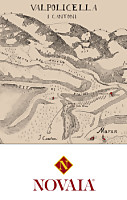
|
|
Valpolicella Classico Superiore I Cantoni 2013 |
|
| Novaia (Veneto, Italy) | |
 Corvina, Corvinone, Rondinella Corvina, Corvinone, Rondinella | |
| Price: € 16.00 | Score: |
 Brilliant ruby red and nuances of garnet red, little transparency. Brilliant ruby red and nuances of garnet red, little transparency. Intense, clean, pleasing and refined, starts with hints of blackberry,
plum and dried violet followed by aromas of black cherry, raspberry,
chocolate, tobacco, graphite, cinnamon, vanilla and menthol. Intense, clean, pleasing and refined, starts with hints of blackberry,
plum and dried violet followed by aromas of black cherry, raspberry,
chocolate, tobacco, graphite, cinnamon, vanilla and menthol.
 Properly tannic attack and however balanced by alcohol, good body,
intense flavors, agreeable. Properly tannic attack and however balanced by alcohol, good body,
intense flavors, agreeable.
 Persistent finish with flavors of blackberry, plum and black cherry. Persistent finish with flavors of blackberry, plum and black cherry. 18 months in cask, 4 months in bottle. 18 months in cask, 4 months in bottle. |
|
 Roasted meat, Stewed meat with mushrooms, Broiled meat and barbecue, Hard cheese Roasted meat, Stewed meat with mushrooms, Broiled meat and barbecue, Hard cheese |
|
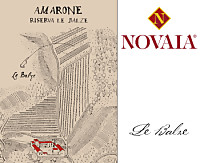
|
|
Amarone della Valpolicella Classico Riserva Le Balze 2011 |
|
| Novaia (Veneto, Italy) | |
 Corvina, Corvinone, Rondinella, Oseleta Corvina, Corvinone, Rondinella, Oseleta | |
| Price: € 48.00 | Score: |
 Intense ruby red and nuances of garnet red, little transparency. Intense ruby red and nuances of garnet red, little transparency. Intense, clean, pleasing, refined and elegant, starts with hints of
blackberry, plum and dried violet followed by aromas of blueberry,
chocolate, tobacco, licorice, cinnamon, mace, leather, vanilla and menthol. Intense, clean, pleasing, refined and elegant, starts with hints of
blackberry, plum and dried violet followed by aromas of blueberry,
chocolate, tobacco, licorice, cinnamon, mace, leather, vanilla and menthol.
 Tannic attack and however balanced by alcohol, full body, intense
flavors, pleasing roundness. Tannic attack and however balanced by alcohol, full body, intense
flavors, pleasing roundness.
 Persistent finish with flavors of blackberry, plum and black cherry. Persistent finish with flavors of blackberry, plum and black cherry. 36 months in cask, 8 months in bottle. 36 months in cask, 8 months in bottle. |
|
 Game, Roasted meat, Braised and stewed meat, Hard cheese Game, Roasted meat, Braised and stewed meat, Hard cheese |
|
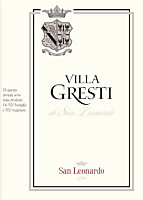
|
|
Villa Gresti 2014 |
|
| Tenuta San Leonardo (Trentino, Italy) | |
 Merlot (90%), Carmenère (10%) Merlot (90%), Carmenère (10%) | |
| Price: € 23.00 | Score: |
 Intense ruby red and nuances of garnet red, little transparency. Intense ruby red and nuances of garnet red, little transparency. Intense, clean, pleasing, refined and elegant, starts with hints of
black currant, black cherry and plum followed by aromas of violet,
blueberry, iris, face powder, chocolate, tobacco, cinnamon, pink pepper,
bell pepper, vanilla and eucalyptus. Intense, clean, pleasing, refined and elegant, starts with hints of
black currant, black cherry and plum followed by aromas of violet,
blueberry, iris, face powder, chocolate, tobacco, cinnamon, pink pepper,
bell pepper, vanilla and eucalyptus.
 Properly tannic attack and however balanced by alcohol, full body,
intense flavors, pleasing roundness. Properly tannic attack and however balanced by alcohol, full body,
intense flavors, pleasing roundness.
 Persistent finish with flavors of black currant, black cherry and plum. Persistent finish with flavors of black currant, black cherry and plum. 14 months in barrique, at least 12 months in bottle. 14 months in barrique, at least 12 months in bottle. |
|
 Game, Roasted meat, Stewed and braised meat with mushrooms, Hard cheese Game, Roasted meat, Stewed and braised meat with mushrooms, Hard cheese |
|
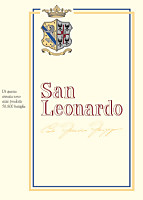
|
|
San Leonardo 2014 |
|
| Tenuta San Leonardo (Trentino, Italy) | |
 Cabernet Sauvignon (60%), Carmenère (30%), Merlot (10%) Cabernet Sauvignon (60%), Carmenère (30%), Merlot (10%) | |
| Price: € 55.00 | Score: |
 Intense ruby red and nuances of garnet red, little transparency. Intense ruby red and nuances of garnet red, little transparency. Intense, clean, pleasing, refined and elegant, starts with hints of
black currant, black cherry and plum followed by aromas of violet,
blueberry, raspberry, iris, tobacco, chocolate, face powder, cardamom,
cigar box, mace, bell pepper, vanilla and eucalyptus. Intense, clean, pleasing, refined and elegant, starts with hints of
black currant, black cherry and plum followed by aromas of violet,
blueberry, raspberry, iris, tobacco, chocolate, face powder, cardamom,
cigar box, mace, bell pepper, vanilla and eucalyptus.
 Tannic attack and however balanced by alcohol, full body, intense
flavors, agreeable. Tannic attack and however balanced by alcohol, full body, intense
flavors, agreeable.
 Very persistent finish with long flavors of black currant, black cherry
and plum. Very persistent finish with long flavors of black currant, black cherry
and plum.
 24 months in barrique, at least 18 months in bottle. 24 months in barrique, at least 18 months in bottle. |
|
 Game, Roasted meat, Stewed and braised meat, Hard cheese Game, Roasted meat, Stewed and braised meat, Hard cheese |
|
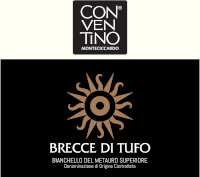
|
|
Bianchello del Metauro Superiore Brecce di Tufo 2016 |
|
| Il Conventino di Monteciccardo (Marches, Italy) | |
 Biancame Biancame | |
| Price: € 16.00 | Score: |
 Intense golden yellow and nuances of golden yellow, very transparent. Intense golden yellow and nuances of golden yellow, very transparent. Intense, clean, pleasing, refined and elegant, starts with hints of
quince, ripe peach and papaya followed by aromas of pear, medlar,
grapefruit, hawthorn, plum, praline, butter, almond and vanilla. Intense, clean, pleasing, refined and elegant, starts with hints of
quince, ripe peach and papaya followed by aromas of pear, medlar,
grapefruit, hawthorn, plum, praline, butter, almond and vanilla.
 Crisp attack and however balanced by alcohol, good body, intense
flavors, pleasing roundness. Crisp attack and however balanced by alcohol, good body, intense
flavors, pleasing roundness.
 Persistent finish with flavors of quince, papaya and grapefruit. Persistent finish with flavors of quince, papaya and grapefruit. 10 months in cask, 2 months in bottle. 10 months in cask, 2 months in bottle. |
|
 Stuffed pasta, Mushroom soups, Roasted fish, Roasted white meat Stuffed pasta, Mushroom soups, Roasted fish, Roasted white meat |
|
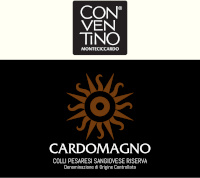
|
|
Colli Pesaresi Sangiovese Riserva Cardomagno 2014 |
|
| Il Conventino di Monteciccardo (Marches, Italy) | |
 Sangiovese Sangiovese | |
| Price: € 19.50 | Score: |
 Intense ruby red and nuances of garnet red, little transparency. Intense ruby red and nuances of garnet red, little transparency. Intense, clean, pleasing, refined and elegant, starts with hints of
black cherry, plum and violet followed by aromas of blueberry, blackberry,
chocolate, tobacco, cardamom, licorice, rhubarb, mace, vanilla and menthol. Intense, clean, pleasing, refined and elegant, starts with hints of
black cherry, plum and violet followed by aromas of blueberry, blackberry,
chocolate, tobacco, cardamom, licorice, rhubarb, mace, vanilla and menthol.
 Properly tannic attack and however balanced by alcohol, full body,
intense flavors, agreeable. Properly tannic attack and however balanced by alcohol, full body,
intense flavors, agreeable.
 Persistent finish with flavors of black cherry, plum and blueberry. Persistent finish with flavors of black cherry, plum and blueberry. 24 months in barrique, 12 months in bottle. 24 months in barrique, 12 months in bottle. |
|
 Game, Roasted meat, Stewed and braised meat, Hard cheese Game, Roasted meat, Stewed and braised meat, Hard cheese |
|
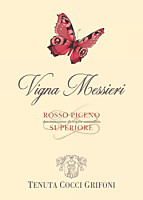
|
|
Rosso Piceno Superiore Vigna Messieri 2013 |
|
| Tenuta Cocci Grifoni (Marches, Italy) | |
 Montepulciano (70%), Sangiovese (30%) Montepulciano (70%), Sangiovese (30%) | |
| Price: € 16.00 | Score: |
 Intense ruby red and nuances of garnet red, little transparency. Intense ruby red and nuances of garnet red, little transparency. Intense, clean, pleasing and refined, starts with hints of plum, black
cherry and dried violet followed by aromas of blackberry, blueberry,
tobacco, black pepper, cocoa, leather, vanilla and menthol. Intense, clean, pleasing and refined, starts with hints of plum, black
cherry and dried violet followed by aromas of blackberry, blueberry,
tobacco, black pepper, cocoa, leather, vanilla and menthol.
 Properly tannic attack and however balanced by alcohol, good body,
intense flavors, agreeable. Properly tannic attack and however balanced by alcohol, good body,
intense flavors, agreeable.
 Persistent finish with flavors of plum, black cherry and blackberry. Persistent finish with flavors of plum, black cherry and blackberry. 24 months in cask, 6 months in bottle. 24 months in cask, 6 months in bottle. |
|
 Broiled meat and barbecue, Roasted meat, Stewed and braised meat with mushrooms, Hard cheese Broiled meat and barbecue, Roasted meat, Stewed and braised meat with mushrooms, Hard cheese |
|
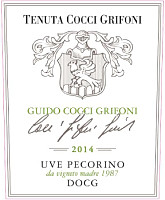
|
|
Offida Pecorino Guido Cocci Grifoni 2014 |
|
| Tenuta Cocci Grifoni (Marches, Italy) | |
 Pecorino Pecorino | |
| Price: € 25.00 | Score: |
 Brilliant straw yellow and nuances of straw yellow, very transparent. Brilliant straw yellow and nuances of straw yellow, very transparent. Intense, clean, pleasing, refined and elegant, starts with hints of
apple, medlar and plum followed by aromas of pear, peach, bergamot,
grapefruit, hazelnut, pineapple, hawthorn, anise, broom, marjoram, sage and
mineral. Intense, clean, pleasing, refined and elegant, starts with hints of
apple, medlar and plum followed by aromas of pear, peach, bergamot,
grapefruit, hazelnut, pineapple, hawthorn, anise, broom, marjoram, sage and
mineral.
 Crisp attack and however balanced by alcohol, good body, intense
flavors, pleasing roundness. Crisp attack and however balanced by alcohol, good body, intense
flavors, pleasing roundness.
 Very persistent finish with long flavors of apple, peach, plum and
medlar. Very persistent finish with long flavors of apple, peach, plum and
medlar.
 18 months in steel tanks, at least 6 months in bottle. 18 months in steel tanks, at least 6 months in bottle. |
|
 Stuffed pasta, Roasted fish, Roasted white meat, Mushroom soups Stuffed pasta, Roasted fish, Roasted white meat, Mushroom soups |
|
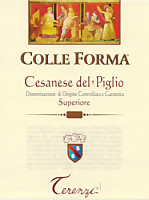
|
|
Cesanese del Piglio Superiore Colle Forma 2016 |
|
| Terenzi (Latium, Italy) | |
 Cesanese d'Affile Cesanese d'Affile | |
| Price: € 11.00 | Score: |
 Intense ruby red and nuances of ruby red, little transparency. Intense ruby red and nuances of ruby red, little transparency. Intense, clean, pleasing and refined, starts with hints of black
cherry, blueberry and plum followed by aromas of violet, raspberry, carob,
black pepper and vanilla. Intense, clean, pleasing and refined, starts with hints of black
cherry, blueberry and plum followed by aromas of violet, raspberry, carob,
black pepper and vanilla.
 Properly tannic attack and however balanced by alcohol, good body,
intense flavors, agreeable. Properly tannic attack and however balanced by alcohol, good body,
intense flavors, agreeable.
 Persistent finish with flavors of black cherry, blueberry and plum. Persistent finish with flavors of black cherry, blueberry and plum. 24 months in cask, 12 months in bottle. 24 months in cask, 12 months in bottle. |
|
 Stuffed pasta with mushrooms, Broiled meat and barbecue, Roasted meat, Stewed meat Stuffed pasta with mushrooms, Broiled meat and barbecue, Roasted meat, Stewed meat |
|
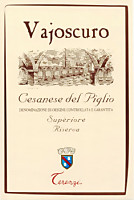
|
|
Cesanese del Piglio Superiore Riserva Vajoscuro 2015 |
|
| Terenzi (Latium, Italy) | |
 Cesanese d'Affile Cesanese d'Affile | |
| Price: € 16.50 | Score: |
 Intense ruby red and nuances of garnet red, little transparency. Intense ruby red and nuances of garnet red, little transparency. Intense, clean, pleasing and refined, starts with hints of plum, black
cherry and violet followed by aromas of blueberry, raspberry, carob,
tobacco, mace, vanilla and menthol. Intense, clean, pleasing and refined, starts with hints of plum, black
cherry and violet followed by aromas of blueberry, raspberry, carob,
tobacco, mace, vanilla and menthol.
 Properly tannic attack and however balanced by alcohol, good body,
intense flavors, agreeable. Properly tannic attack and however balanced by alcohol, good body,
intense flavors, agreeable.
 Persistent finish with flavors of plum, black cherry and blueberry. Persistent finish with flavors of plum, black cherry and blueberry. 12 months in cask, 12 months in bottle. 12 months in cask, 12 months in bottle. |
|
 Broiled meat and barbecue, Roasted meat, Stewed meat with mushrooms, Hard cheese Broiled meat and barbecue, Roasted meat, Stewed meat with mushrooms, Hard cheese |
|
News |
|
In this section are published news and information about events concerning the world of wine and food. Whoever is interested in publishing this kind of information can send us a mail to our address.
|
AquavitaeReview of Grappa, Distillates and Brandy |
|
|
||||||||||||
Wine Guide ParadeOctober 2018
|
| |||||||
Privacy Policy | |||||||


| Copyright © 2002-2024 Antonello Biancalana, DiWineTaste - All rights reserved |
| All rights reserved under international copyright conventions. No part of this publication and of this WEB site may be
reproduced or utilized in any form or by any means, electronic or mechanical, without permission in writing from DiWineTaste. |